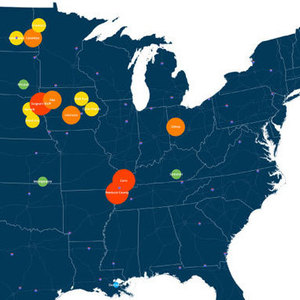Soybean Market Analysis and Implications for Sustainable Development Goals
Executive Summary: Supply, Demand, and SDG Linkages
- A fundamental shift in the U.S. soybean market indicates a reduction in raw exports to accommodate a significant increase in domestic crush for soybean oil.
- This change necessitates a greater reliance on imported oils, specifically canola oil, to meet domestic consumption and industrial feedstock demand.
- The market’s stability is highly dependent on achieving a record-high crop yield amidst reduced planting acreage and increasing climate-related risks.
- These dynamics have direct and significant implications for several Sustainable Development Goals (SDGs), particularly SDG 2 (Zero Hunger), SDG 8 (Decent Work and Economic Growth), SDG 12 (Responsible Consumption and Production), SDG 13 (Climate Action), and SDG 17 (Partnerships for the Goals).
Production Challenges and Food Security (SDG 2 & SDG 13)
- Dependence on Record Yields: The forecast relies on achieving a record-high soybean yield of 52.5 bushels per acre (bpa). This high-risk assumption is critical for maintaining supply, and any shortfall directly threatens food availability and affordability, impacting progress toward SDG 2 (Zero Hunger).
- Reduced Harvested Area: A 3.6-million-acre reduction in harvested soybean area intensifies the pressure on yield performance to meet demand for both domestic crush and export commitments.
- Climate Vulnerability: Forecasts of building heat and dryness present a substantial threat to crop health and final yield. This vulnerability underscores the urgent need for climate-resilient agriculture, a key component of SDG 13 (Climate Action), to safeguard food production systems.
Trade Dynamics and Responsible Consumption (SDG 12 & SDG 17)
- Shift in Consumption Patterns: The decision to cut soybean exports by 70 million bushels to facilitate increased domestic crush represents a significant change in national production and consumption patterns, a central theme of SDG 12 (Responsible Consumption and Production).
- Increased Import Reliance: To satisfy strong demand, soybean oil imports for 2025-26 are projected to increase by 150 million pounds. This highlights a growing dependence on international supply chains.
- International Partnerships: The increased need for canola oil, particularly from Canada and Mexico, emphasizes the importance of robust international trade partnerships. Such cooperation is vital for ensuring supply chain stability and aligns with the objectives of SDG 17 (Partnerships for the Goals).
Market Outlook and Economic Viability (SDG 8)
- Technical Price Indicators: Market chart analysis suggests a bullish outlook, with long-term formations indicating potential for higher prices. Key resistance levels are anticipated near the 60 and 65 cent/pound marks. The stability and growth of commodity prices are fundamental to the economic health of the agricultural sector.
- Investor Sentiment: While managed-money traders have shifted to a net-long position, their investment is far from record levels, indicating substantial buying power could still enter the market.
- Economic Growth Contribution: The performance of the soybean market directly influences the economic viability of farms and related industries, supporting rural livelihoods and contributing to the broader goal of SDG 8 (Decent Work and Economic Growth).
1. Which SDGs are addressed or connected to the issues highlighted in the article?
The following SDGs are connected to the issues in the article:
- SDG 2: Zero Hunger: The article’s core subject is agricultural production, specifically soybean yield. It discusses the importance of achieving a “record high level of 52.5 bushels per acre (bpa)” to meet demand, and the risk of a “lower yield due to adverse weather.” This directly relates to food production, food security, and sustainable agriculture.
- SDG 8: Decent Work and Economic Growth: The entire piece is a market analysis focusing on the economic aspects of the soybean industry. It discusses exports, imports, commodity prices (“60 cent/pound area”), and market speculation (“managed-money traders have returned to the net-long side”). This reflects the economic activity and growth within a key agricultural sector.
- SDG 12: Responsible Consumption and Production: The article details the balancing act between different uses of soybeans. It mentions that “exports of soybeans had to be cut by 70 mb to accommodate the increased crush,” which highlights the management of production patterns to meet different consumption needs (domestic processing vs. international trade).
- SDG 13: Climate Action: The article explicitly links agricultural outcomes to climate and weather events. It notes that a lower yield could result from “adverse weather in August” and points to the “heat and dryness forecast to build into the Corn Belt.” This underscores the vulnerability of food systems to climate-related hazards.
- SDG 17: Partnerships for the Goals: The text touches upon international trade policies and relationships. It mentions that soybean oil imports were increased, giving “a nod to strong canola oil demand” and highlighting the “special treatment allowed to Canadian- and Mexican-grown feedstocks.” This points to the role of trade agreements and partnerships in the global food and agriculture market.
2. What specific targets under those SDGs can be identified based on the article’s content?
Based on the article, the following specific SDG targets can be identified:
- Target 2.4 (under SDG 2): “By 2030, ensure sustainable food production systems and implement resilient agricultural practices that increase productivity and production… and strengthen capacity for adaptation to climate change, extreme weather, drought…” The article’s concern over a “lower yield due to adverse weather” and the sensitivity to “heat and dryness” directly relates to the need for resilient agricultural practices to maintain productivity.
- Target 8.1 (under SDG 8): “Sustain per capita economic growth in accordance with national circumstances…” The market analysis of soybean oil prices, futures, and trading volumes is fundamental to understanding and sustaining the economic health and growth of the agricultural sector discussed.
- Target 12.2 (under SDG 12): “By 2030, achieve the sustainable management and efficient use of natural resources.” The article describes the allocation of the soybean harvest, where “exports of soybeans had to be cut… to accommodate the increased crush.” This is a direct example of managing a natural resource (soybeans) to balance different consumption and production needs (domestic processing vs. export).
- Target 13.1 (under SDG 13): “Strengthen resilience and adaptive capacity to climate-related hazards and natural disasters in all countries.” The article highlights the risk that “heat and dryness” poses to the soybean crop, emphasizing the agricultural sector’s vulnerability and the implicit need for greater resilience to climate-related hazards to avoid “serious implications.”
- Target 17.11 (under SDG 17): “Significantly increase the exports of developing countries…” While the article focuses on the US, it operates within the context of global trade. The discussion of cutting soybean exports while increasing canola oil imports from Canada and Mexico illustrates the complex international trade dynamics and policies that govern agricultural commodities.
3. Are there any indicators mentioned or implied in the article that can be used to measure progress towards the identified targets?
The article mentions or implies several indicators for measuring progress:
- Indicator for Target 2.4: Agricultural productivity/yield. The article provides a precise quantitative measure: “yield to hit the record high level of 52.5 bushels per acre (bpa).” This serves as a direct indicator of agricultural productivity.
- Indicators for Target 12.2: Volume of imports and exports. The article gives specific figures that can be used as indicators of resource management and trade balance, such as “imports had to be increased by 150 million pounds” and “exports of soybeans had to be cut by 70 mb.”
- Indicator for Target 8.1: Commodity prices. The text refers to specific market prices, such as resistance levels at “51 and 54.50” and the “60 cent/pound area.” Commodity prices are a key indicator of economic activity and value in the sector.
- Indicator for Target 13.1: Impact of weather events on agricultural output. The article implies this indicator by stating that “a lower yield due to adverse weather in August would have serious implications.” Measuring the variance in yield based on weather patterns would be a way to track resilience.
- Indicator for Target 17.11: Volume of trade with specific partners. The mention of increased imports and “special treatment allowed to Canadian- and Mexican-grown feedstocks” implies that the volume of trade with these specific countries is a measurable indicator of international partnerships.
4. Table of SDGs, Targets, and Indicators
| SDGs | Targets | Indicators Identified in the Article |
|---|---|---|
| SDG 2: Zero Hunger | Target 2.4: Ensure sustainable food production systems and implement resilient agricultural practices that increase productivity. | Agricultural Yield: “record high level of 52.5 bushels per acre (bpa).” |
| SDG 8: Decent Work and Economic Growth | Target 8.1: Sustain per capita economic growth. | Commodity Prices: “resistance found at 51 and 54.50… and the 60 cent/pound area.” |
| SDG 12: Responsible Consumption and Production | Target 12.2: Achieve the sustainable management and efficient use of natural resources. | Import/Export Volumes: “imports had to be increased by 150 million pounds,” “exports of soybeans had to be cut by 70 mb.” |
| SDG 13: Climate Action | Target 13.1: Strengthen resilience and adaptive capacity to climate-related hazards. | Vulnerability to Weather: “a lower yield due to adverse weather in August,” “sensitive to the heat and dryness forecast.” |
| SDG 17: Partnerships for the Goals | Target 17.11: Significantly increase the exports of developing countries. | Trade with Partners: “special treatment allowed to Canadian- and Mexican-grown feedstocks.” |
Source: dtnpf.com







